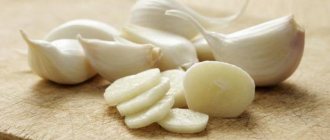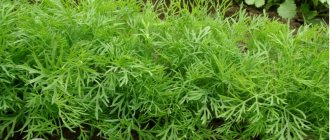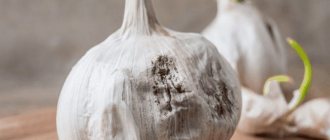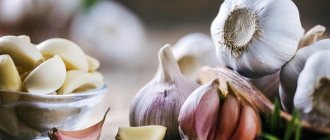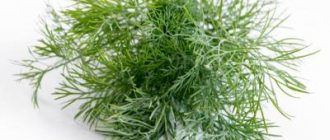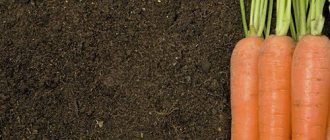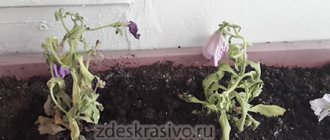≡ March 3, 2021
← Pilot's story
Petersburgers to St. Petersburg →
Yesterday I salted the lard, and today the garlic on it turned green, this has never happened before, what should I do - throw it away or is this normal?
A lot of questions like this are asked. Let's look at which garlic turns green and why. And most importantly, is it dangerous? Will the products in which the garlic has turned green be spoiled?
Russia has long been famous for its abundance of myths. This type of “folklore” did not ignore the so-called Chinese garlic. Not the one whose second name is fragrant onion, scientifically - Allium chinens, with heads like small onion sets, but the one that today has flooded all the stores in Russia and a significant part of the planet. For China now controls about 77% of the world's exports of this spicy plant.
However, all over the world the name “garlic of Chinese selection” has taken root. For example, in Spain, the leading European country in the production of this spicy product, 15–20% of the area is allocated to the Chinese variety. About 20–25% are allocated to the Spanish zoned variety of the same Chinese selection, called the “white variety,” and over half of all garlic plantations are allocated to the local dark purple variety, called “Morado.”
There are all kinds of rumors and gossip about the Chinese variety. A Russian man in the street, having once bought Chinese sneakers at a bargain price, made in China according to the technical specifications of a Russian entrepreneur, takes offense at everything produced in this country. At the same time, he forgets the simple truth that cheap things cannot be of high quality, and half of the planet uses Chinese goods and products without any complaints. Because all these products comply with the strictest international standards (which is confirmed by laboratory tests), or... the technical specifications of the customer, which are dictated by the demand of the same Russian offended average person.
What scientists say
On the problem of changing the color of garlic cloves, scientists conducted full-fledged research and found the reason. It turns out that they contain a special substance – allicin. It is because of this that the color changes.
Attention! Recent studies confirm that allicin is a beneficial substance that, among other actions, prevents the development of cancer cells.
Allicin forms pigments that color the flesh blue or green. A color change occurs when the integrity of the surface of the cloves is damaged (damage, cuts and grinding).
Important! The fact of pigmentation and color intensity depend little on the variety. Scientists have found that greening or blueness depends on the location of cultivation and the degree of maturity of the cloves.
Here are the patterns that were noticed:
- If garlic grew in southern countries with warm climates, it contains more allicin, unlike its relatives from countries with cool climates.
- Over time during storage, the concentration of allicin increases.
- Young or unripe teeth contain less allicin than well-ripened teeth.
- The presence of microelements (iron, zinc, copper, chromium, etc.) in the product does not affect the color intensity.
Why does garlic turn green: myths and reality
Lately, many housewives have been concerned about the question of why garlic added to food, marinades or pickles takes on an unusual blue-green hue? It happens that we bought fresh lard at the market, salted it, stuffed it with garlic, and the next morning, instead of a snow-white slice covered with herbs and spices, we get plates with beautiful, but terrifying green veins of aromatic slices.And it happens that when salting or pickling whole heads or individual cloves, as well as when adding vegetables to the rolls of tomatoes, squash, cabbage, mushrooms and other fruits, their flesh acquires an intense color, varying from green to blue. But the main concern of housewives, which excites minds and gives rise to a lot of myths, is whether such a product is harmful to health, and can it be eaten?
Debunking myths
There are two myths regarding garlic turning green or turning blue.
The first is that this vegetable is genetically modified (GMO).
Secondly, the bulbs contain dangerous chemicals (nitrates, heavy metal salts, toxic compounds, carcinogens, etc.) that were used in growing the crop. And since the ones that were brought from China turn green more often than other bulbs, our population has a special, to put it mildly negative, attitude towards Chinese garlic.
Let's debunk these myths. Anyone who is terrified of GM types of various products can rest easy. Currently, not a single genetically modified type of garlic has been bred on our planet.
This is simply not necessary, since the onion crop, growing and cultivated in most climatic zones, has many varieties that can independently cope with both pests and pathogens. In other cases, to get rid of parasites and diseases in plantings, it is enough to use time-tested biological or modern synthetic insecticides and fungicides.
So why does garlic, most often Chinese, turn green? It turns out that certain substances that are formed in the bulbs as a result of chemical reactions are responsible for the pigmentation of the bulbs. For those who do not want to understand the scientific intricacies, let's say right away: green garlic is a normal phenomenon, it is absolutely safe for consumption, and in some cases even healthier than ordinary milky white cloves.
For everyone else, without going deep into chemical terms, the problem looks like this. When garlic tissues are damaged (chopping, pureing, grinding), the organic sulfur-containing substance alliin is released from the pulp, which, in turn, is formed from the amino acid cysteine.
It reacts with other plant compounds - essential oils and the enzyme allicinase. As a result of these processes, some alliin molecules are converted into allicin, pyruvic acid and ammonia. The other part, due to a reaction with amino acids present in the pulp of the cloves, forms the same coloring substances - blue or green pigments.
But whether garlic changes its color during cooking depends on the ratio of the amount of enzyme and alliin. Moreover, the line between this ratio is so thin that the same variety of garlic, collected from different but adjacent beds, can either give a similar reaction or not.
Since the presence of amino acids in the bulbs stimulates the pigmentation of the pulp, it is regularly observed during culinary processing (temperature from +40 to +80°C), and most often the reaction of pigment formation occurs in a slightly acidic environment. And these are various marinades and solutions for pickling with vinegar.
So the formation of bright pigments does not depend at all on the presence of metal salts and the amount of microelements in the vegetable. The pigmentation of garlic is directly related to the degree of maturity of the bulbs, the climatic conditions of growth and the method of storing the harvest.
And now the answer to the question, why does garlic brought from China most often turn green?
Firstly, China is the main supplier of garlic on the world market, so in winter the likelihood of buying just such a vegetable in our supermarkets is quite high. And secondly, the maximum concentration of substances (sulfur-containing compounds and enzymes), during the reaction of which pigmentation occurs, contains garlic grown in a warm climate.
For us, these are the southern regions of Russia, Crimea, Krasnodar Territory. It is there that the plant not only fully matures, but also accumulates large doses of all phytonutrients. And in the northern regions and in the middle zone, the concentration of alliin and esters in garlic is significantly lower. By the way, garlic from Egypt, Spain and other Mediterranean countries, as well as Kazakhstan and Uzbekistan, turns green just as often as those brought from China.
And therefore, garlic that is fully ripened in a warm climate and has accumulated sulfur-containing elements turns green much more often (almost always) than its counterpart collected in Russia, Ukraine, and Moldova.
Under what conditions is the likelihood of the formation of coloring pigments in garlic significantly reduced?
Freshly picked and not yet dried bulbs that have not reached the full ripening phase almost never turn green.
The concentration of alliin and enzymes increases during storage, especially in cold storage (the temperature in well-ventilated areas of vegetable stores ranges from +1 to +4°C).
But storing garlic in a warm way at temperatures from +16 to +22°C can even cause a decrease in the number of compounds whose reactions with each other lead to the appearance of pigments.
So, calmly buy Chinese garlic if the bulbs you grow yourself or buy from your grandmothers at the local market are already completely used up, which usually happens by the end of winter. Good health to you!
Color change when used in cooking
Garlic is a valuable food product. However, it is worth considering some features of its use in cooking. Let's take a closer look at them.
When canning
Often, when using aromatic cloves in rolls with cucumbers, tomatoes or mushrooms, they turn green. They don't look too appetizing in the marinade. This is what it looks like:
To prevent this from happening, experienced housewives advise preserving only young garlic. It is recommended to clean the slices by hand so as not to damage their shell. After sealing, it is advisable to store the jars in a cool place.
When salting or fermenting, proceed in the same way: prepare only young garlic. Without heat treatment and cuts on the cloves.
For frying and baking
Crushed garlic often changes color in hot dishes - fried potatoes, mushrooms and broths. This is facilitated by the temperature factor and processing time. The longer a product sits in a dish, the more likely it is to change color.
How to avoid turning blue or green? The answer is: add garlic to dishes at the very end of frying or baking (or just before serving). In other words, it needs to be cooked less.
Attention! Dried garlic can be used in hot dishes. It doesn't change color.
When salting lard
Garlic is one of the main ingredients in many recipes for salting lard. Over time, it can also change its color.
This is mainly due to the time factor. The lard is salted for several hours, and the garlic has time to change color.
Experienced housewives advise not to crush it with a garlic press, but to chop it coarsely with a ceramic knife. This will slow down the greening process significantly.
Is it possible to eat blue or green garlic?
In those southern countries where garlic is grown in huge quantities, people do not even notice that it changes color. This process is normal. Therefore, you don’t have to worry about this either.
Neither garlic that has turned green nor teeth that have turned blue when cooking, preserving or salting will cause harm or danger to the human body. Therefore, never fill your own head with such inventions. Try to enjoy the dishes you love so much with great pleasure!
Using imported garlic in preservation
We offer you preservation recipes during which garlic never changes color:
Recipe 1:
To prepare, stock up on:
- Cucumbers – 4 kg
- Parsley – 2 bunches
- Vegetable oil – 200 ml
- Vinegar – 200 ml
- Sugar – 180 g
- Garlic – 16 tooth
- Salt – 120 g
Cooking process:
- Wash the cucumbers and cut into slices. Place in a saucepan.
- Chop the parsley. Send to cucumbers.
- Pour in oil and vinegar. Add spices.
- Divide the garlic lengthwise to form cloves. Add to other ingredients.
- Leave the components for 6 hours.
- Then put them in jars and fill them with marinade.
- Sterilize for 25 minutes.
- Roll it up.
Changing the color of imported garlic in canning
Recipe 2:
For the recipe, stock up on:
- Sweet pepper – 2.5 kg
- Water – 100 ml
- Oil – 200 ml
- Salt – 45 g
- Sugar – 100 g
- Vinegar – 100 ml
- Black pepper, allspice
- Garlic – 2 goals
Cooking process:
- Peel the pepper and cut into pieces.
- Peel the garlic. Make sure it is not damaged.
- Boil water in a saucepan, add pepper, simmer for 4 minutes. Drain the water and place the peppers on a plate to cool.
- Add oil and spices to the water. Boil, add pepper again and cook for 4 minutes. Remove the pepper and set aside to cool.
- Add garlic to the marinade and simmer for 2 minutes.
- Place garlic, hot pepper and allspice into a clean jar.
- Add sweet pepper.
- Boil the marinade and pour it into jars with pepper.
- Roll it up.
Cooking tricks
To make food look more aesthetically pleasing (without green or blue spots of garlic), housewives use the following culinary “life hacks”:
- Only young garlic is used in cooking;
- when marinating or salting, peel the slices with your fingers;
- The teeth are pickled exclusively in a cold way, the marinade is not subjected to heat treatment;
- keep the preserves cool;
- dried garlic is added to hot dishes;
- fresh garlic is added when frying or baking at the very end of cooking.
How to avoid this?
So, we found out why garlic turns green during heat treatment. What to do about it? Many housewives are afraid of such garlic, although there is nothing harmful in it.
But to avoid discoloration of the crop, you need to follow some rules.
- Fewer substances that are responsible for pigmentation are contained in young and freshly harvested crops.
- It is best to store the product in a warm room, because... at temperatures from 0 to +5 degrees, garlic begins to turn green faster.
- To slow down the change in pigmentation, the plant must first be blanched for a few minutes.
- It is best to peel it with your hands so as not to damage the skin. Any cut provokes the work of substances responsible for pigmentation.
- When preparing a hot dish that uses ground or crushed garlic, the product must first be dried or fried.
- The plant should be salted and pickled only in a cold way.
- Store all preparations in a cold room.
- Garlic is served separately from hot dishes.
Let's sum it up
Now you know why garlic turns green or blue during cooking. Almost any garlic changes color if you damage the shell of the clove or cut it. The degree of color change depends on the place of cultivation (southern or northern region) and the time of ripening (young or mature).
However, with a change in color, the product does not become harmful or dangerous to human health. Therefore, it can be safely added to various dishes and stored for the winter.
Elena Malysheva about garlic
History of origin
Normal and spoiled garlic puree
Until the 50s of the 20th century, there were no special questions about the blueness of garlic - probably because each housewife had her own tricks for preparing it. But in the 50s, industrial garlic preservation was launched in America, and problems began. Large batches of products were rejected due to blue discoloration, and the industry suffered serious losses because of this. At that time, garlic began to be prepared in the form of puree, which was then preserved. The cloves were crushed, the resulting paste was mixed with salt and vinegar, and then rolled into containers. The situation required a study, for which biochemists were involved.
